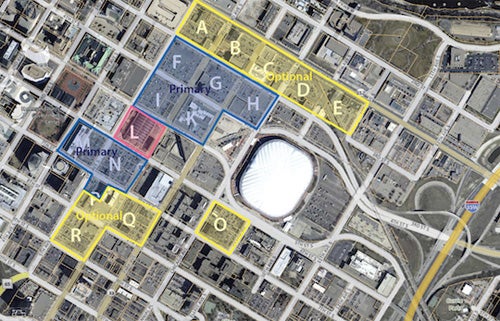Five student teams from the University of Oregon competed in the 2013 Urban Land Institute’s (ULI) Gerald D. Hines Student Urban Design Competition, which attracted 149 team entries from 70 universities in the United States and Canada. The competition seeks to transform cities through sustainable urban design.
 The five cross-disciplinary teams in this year’s competition from UO included students from the School of Architecture and Allied Arts in Eugene and Portland working with students from Columbia University in New York City. This year’s numbers represented the largest involvement by the UO. Each team was made up of five students from at least three disciplines and a faculty adviser.
The five cross-disciplinary teams in this year’s competition from UO included students from the School of Architecture and Allied Arts in Eugene and Portland working with students from Columbia University in New York City. This year’s numbers represented the largest involvement by the UO. Each team was made up of five students from at least three disciplines and a faculty adviser.
The competition encourages cooperation and real world teamwork between graduate students from design, business, urban planning, historic preservation, and law, to name a few.
“While it’s disappointing we didn’t win, the competition is more importantly about being a part of this interdisciplinary competition and learning from your teammates and the process,” says landscape architecture Assistant Professor Deni Ruggeri, adviser at UO for the annual competition. Along with Ruggeri, faculty team leaders from UO included architecture Professor Michael Fifield and three more from other UO professional schools.
“The ULI design competition is one of the rare opportunities for a dialogue across disciplines,” Ruggeri says. “The teamwork speaks to my pedagogy and the notion of interdisciplinary collaboration around urban, environmental design projects. The student interdisciplinary collaboration is the exciting thing to witness, and is the number one reason why I have chosen to organize and facilitate the competition.”
This year’s urban design competition location was a 17.5-acre site in Minneapolis’s Downtown East neighborhood, near the site of the new Minnesota Vikings stadium. Minneapolis hopes to see this section of downtown grow into a "Complete Community" and a regional destination through thriving mixed-use redevelopment with its roots in transit-oriented development. The goal was to develop solutions for the project site, which included drawings, site plans, visual renderings, and market-feasible financial data. The teams were introduced to the site on the first day of the competition, which was January 14, and were given two weeks to complete the project, which culminated January 28.
The timeline for the competition makes for a daunting project. Graduate student Vanessa Nevers, an architecture and landscape architecture major, built off her previous experience in the competition when her team finished in the top 11 in 2011, the first year the UO entered. “The most important lesson I learned from my first ULI competition was to have a well-rounded team composed of individuals with a variety of strengths who are truly passionate about their interests,” says Nevers.
 Nevers’ teammate graduate business student Ryan Strub found the cross-discipline nature of the competition tangible to his career goals. “This project allowed me to take a step toward my career aspirations of building sustainable communities that promote healthy, sustainable lifestyles by providing me the opportunity to work with talented, like-minded individuals,” Strub says. “Working with people studying different disciplines was a great experience as it replicated the group dynamics in real-life firms.”
Nevers’ teammate graduate business student Ryan Strub found the cross-discipline nature of the competition tangible to his career goals. “This project allowed me to take a step toward my career aspirations of building sustainable communities that promote healthy, sustainable lifestyles by providing me the opportunity to work with talented, like-minded individuals,” Strub says. “Working with people studying different disciplines was a great experience as it replicated the group dynamics in real-life firms.”
If the crunched timeline was not enough of a challenge, this year’s UO teams added another opportunity: distant team collaboration and project development. With team members at A&AA in Portland, and another in New York City at Columbia University, landscape architecture graduate student Deven Young had to rely on today’s technology to complete the project.
“I learned several lessons throughout the competition but the most notable was balancing ideas and duties through a virtual medium,” says Young. “My team used video conferencing nightly and shared all of our work on a community server. In today's global environment this type of collaboration is commonplace and this competition became my first stab at what I am sure will become a regular practice in my future professional work.”
Four finalist teams were named in late February, earning $50,000 for the winning team and $10,000 for each of the three runners-up. UO was not among the top four.
For Ruggeri, winning would have provided added recognition, but it was not what drives him or students to compete. “There is a level of rigor that is required in this competition that you can’t get anywhere else. To me they are all winners in the end, because they engaged in this competition and they’ve all grown exponentially in just two short weeks.”
Story by Joe McAndrew
